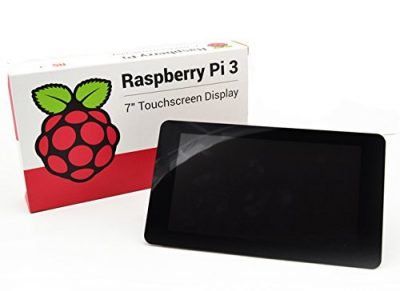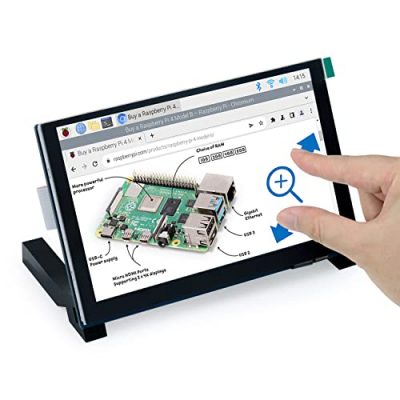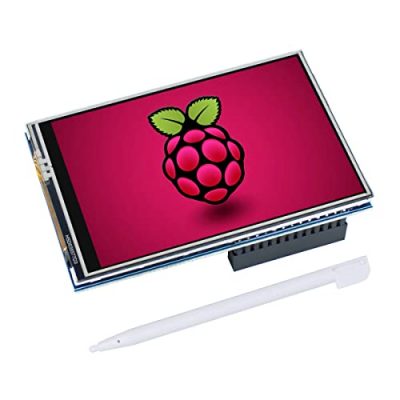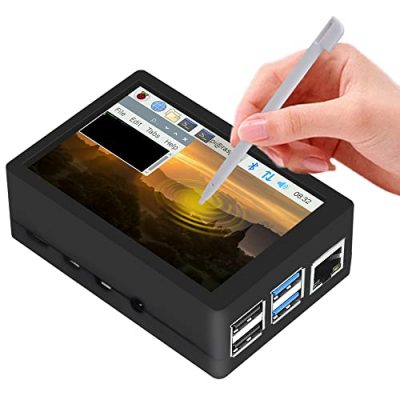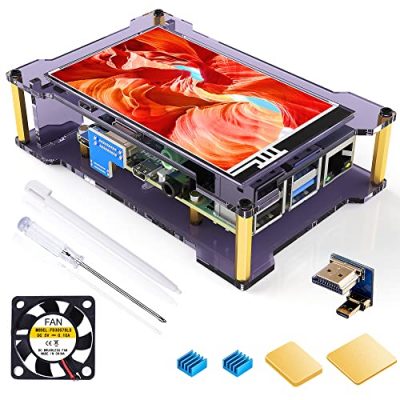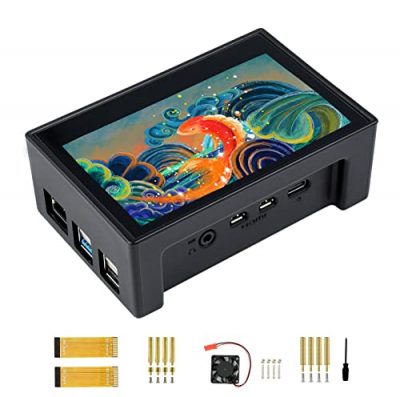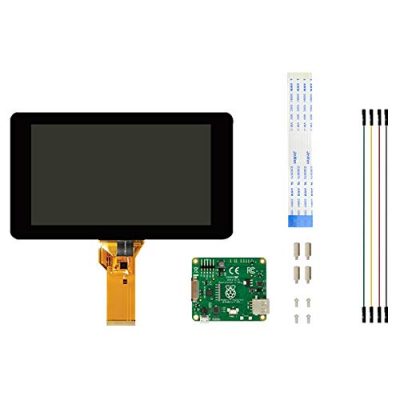Introducing the remarkable world of Raspberry Pi 4 Touchscreens for 2023. Looking to upgrade your tech game? Look no further! This dynamic selection of 8 amazing touchscreen options for the Raspberry Pi 4 will surely captivate both tech enthusiasts and professionals alike. With their impressive features, sleek designs, and seamless functionality, these touchscreens are set to revolutionize the way we interact with our favorite mini computers. From enhanced visuals to crisp touch response, these cutting-edge displays are tailored to cater to all your diverse needs. Join us on this exciting journey as we explore the top 8 Raspberry Pi 4 touchscreens for 2023.
The Raspberry Pi Official 7 Inch Touch Screen is a high-quality display designed specifically for Raspberry Pi 4, 3, and 2 Model B. It allows users to reduce the periphery of their Raspberry Pi setup by eliminating the need for a separate monitor. The touchscreen is slim, easy to use, and offers a straightforward setup process. The screen is perfect for various projects, including 3D printing, thin clients, media servers, and more. It has a vibrant Raspberry color and a good resolution. However, it lacks a brightness adjustment feature. The DSI screen connector is native to Raspberry Pi, but the resolution may be lower compared to generic touch screens. The screen comes with no assembly instructions, and the port orientation may require additional configuration. Overall, it is an excellent purchase for Raspberry Pi enthusiasts and DIY projects.
Key Features
Specifications
Pros
Cons
The Raspberry Pi Official 7 Inch Touch Screen is a fantastic addition to any Raspberry Pi setup. It offers a sleek and slim design, easy setup process, and vibrant display. While it lacks a brightness adjustment feature and may have a lower resolution compared to some generic touch screens, it still provides excellent value for its price. The touch screen is highly responsive, making it ideal for various projects and applications. The only drawback is the lack of assembly instructions and the need for additional configuration due to the port orientation. Overall, if you’re a Raspberry Pi enthusiast or looking for a reliable touchscreen display for your DIY projects, this is definitely worth considering.
The NeeGo Raspberry Pi 4 Screen Case is a protective case designed to house both the Raspberry Pi 4 board and the official Raspberry Pi 7-inch LCD touchscreen display. It offers accessibility to all the ports, including the HDMI, and provides reliable protection for the board and the display. The case comes complete with a Philips screwdriver, making it convenient for users. Its sturdy and rigid design ensures that the screen is well-protected from flexing. Additionally, it features a removable door for easy access to the GPO pins if needed. While there have been some design flaws mentioned in customer reviews, overall, the NeeGo Raspberry Pi 4 Screen Case offers a decent solution for those looking to protect and house their Raspberry Pi 4 board and touchscreen display.
Key Features
Specifications
Pros
Cons
Overall, the NeeGo Raspberry Pi 4 Screen Case offers good protection and accessibility for the Raspberry Pi 4 board and the official 7-inch touchscreen display. While there have been some design flaws reported by customers, such as compatibility issues with certain jumper cables and limited adjustability, it still provides a decent solution for those looking to protect and house their Raspberry Pi setup. The case’s sturdy and rigid design ensures the screen’s protection and the availability of a removable door for GPO pin access adds to its convenience. It may not be the top choice for everyone, but considering its features and its relatively affordable price, it offers a reasonable option for Raspberry Pi enthusiasts.
The FREENOVE 5 Inch Touchscreen Monitor is designed specifically for the Raspberry Pi. With a 5-inch, 800×480 pixel IPS type wide viewing angle display and 5-point touch capacitive screen, this monitor offers easy installation and excellent image quality. It is compatible with various Raspberry Pi models and systems, such as Raspberry Pi 4B, 3B+, 3B, 3A+, 2B, 1B+, and 1A+, as well as Raspberry Pi OS and Ubuntu. No configuration is required, making it user-friendly for new and configuration-unchanged systems. The monitor comes with a color display and compact dimensions of 5.98Lx5.51Wx1.50H. Overall, it is a great option for Raspberry Pi users looking for a driver-free, easy-to-use touchscreen monitor.
Key Features
Specifications
Pros
Cons
The FREENOVE 5 Inch Touchscreen Monitor for Raspberry Pi is a fantastic option for Raspberry Pi users. It offers easy installation, excellent image quality, and a responsive touch screen. It is compatible with various Raspberry Pi models and systems, making it versatile for different projects. The monitor’s compact size and driver-free setup make it user-friendly, while its affordable price adds to its appeal. Although some users experienced calibration issues and wished for brighter brightness settings, overall, this monitor provides great value for its price. Whether you’re using it as a printer display, UI for a 3D printer, or KlipperScreen, the FREENOVE 5 Inch Touchscreen Monitor is a reliable and convenient choice.
The Hosyond 3.5 Inch 480×320 Touch Screen TFT LCD SPI Display Panel is a great accessory for your Raspberry Pi. With a 3.5-inch TFT LCD resistive touch screen, it not only provides a good display effect but also allows for easy navigation with a touch pen. One of the standout features is that it doesn't require an external power supply – simply plug it into your Raspberry Pi board and you're good to go. This touch screen is compatible with various Raspberry Pi versions and supports different systems like Raspbian, Ubuntu, and Kali Linux. In the package, you'll receive the 3.5-inch touch screen and a touch pen, along with project introductions, code, and tutorials. Overall, it offers great value for its affordable price.
Key Features
Specifications
Pros
Cons
The Hosyond 3.5 Inch Touch Screen Display for Raspberry Pi is a budget-friendly option that provides a satisfactory display and touch experience. It is compatible with various Raspberry Pi models and supports multiple systems, making it versatile for different projects. While it may require some configuration to work properly, the included project introduction, code, and tutorial help in overcoming any difficulties. However, beginners may find the setup process confusing. Overall, this touch screen offers good value for its price and is a convenient addition to your Raspberry Pi setup.
The GeeekPi Raspberry Pi 4 TFT 3.5 inch Touch Screen with Case is a comprehensive kit that includes a 3.5-inch resistive touch screen, ABS case, Raspberry Pi fan, and heatsinks. It is fully compatible with Raspberry Pi 4 Model B. The touch screen can be directly inserted into any version of the Raspberry Pi boards, and the ABS case is exclusively designed for Raspberry Pi 4B. The screen offers a resolution of 320×480 and supports Raspbian, Ubuntu, and Kali systems. With a refresh rate of 50fps, it provides stable video and gaming display without any flicker. The package includes an ABS case, a TFT resistive touch screen, aluminum heatsinks, a touch pen, and a cooling fan. Overall, it is a convenient and versatile solution for Raspberry Pi enthusiasts.
Key Features
Specifications
Pros
Cons
The GeeekPi Raspberry Pi 4 TFT 3.5 inch Touch Screen with Case is a comprehensive kit that offers a convenient and versatile solution for Raspberry Pi 4 Model B enthusiasts. With its adjustable screen resolution and compatibility with multiple operating systems, it provides a stable and enjoyable user experience. The included aluminum heatsinks, touch pen, and cooling fan ensure efficient cooling for the Raspberry Pi board. However, the limited compatibility with other Raspberry Pi models and the small screen size may be drawbacks for some users. Overall, this kit is a great value for its price and offers a worthwhile upgrade for Raspberry Pi enthusiasts.
The Miuzei Raspberry Pi 4 Touchscreen with Case Fan is a 4-inch IPS full-angle display monitor with a resolution of 800×480. It supports HDMI input with a refresh rate of up to 60fps. This touchscreen is compatible with Raspberry Pi 4 models and supports systems like Raspbian, Kali-linux, Ubuntu, and Octopi. It also features touch control function with pre-installed driver system image files. The package includes a raspberry pi screen, raspberry pi heatsink, 30mm cooling fan, and a screwdriver. Overall, this touchscreen provides a convenient and cool-looking display solution for Raspberry Pi users.
Key Features
Specifications
Pros
Cons
The Miuzei Raspberry Pi 4 Touchscreen with Case Fan offers a budget-friendly and convenient solution for Raspberry Pi users looking for a compact display monitor. It has a good display quality with easy assembly and plug-and-play functionality. However, it lacks proper touch screen software and support, and the cooling fan attachment could be better. Despite these shortcomings, the included heatsink and cooling fan help with temperature management, and the overall value for money is commendable. With improved instructions and support, this touchscreen could be an excellent choice for Raspberry Pi enthusiasts and beginners.
The 4.3inch DSI LCD Display with Case is a versatile and high-resolution touchscreen designed specifically for the Raspberry Pi 4B. With a hardware resolution of 800×480, wide-angle IPS screen, and toughened glass panel, this display offers clear and crisp visuals. It features a MIPI DSI interface with a refresh rate of up to 60Hz, ensuring smooth performance. The display is compatible with various operating systems including Raspbian, Ubuntu, Kali, WIN10 IoT, and Retropie, and requires no driver installation. Its compact size and protective case make it ideal for various projects. Overall, the 4.3inch DSI LCD Display with Case offers a reliable and user-friendly solution for Raspberry Pi enthusiasts.
Key Features
Specifications
Pros
Cons
The 4.3inch DSI LCD Display with Case is an excellent option for Raspberry Pi enthusiasts looking for a compact and reliable touchscreen solution. With its high resolution and wide-angle IPS screen, it delivers clear and crisp visuals. The display is compatible with multiple operating systems, making it versatile for different projects. The easy installation and driver-free support add to its convenience. The included protective case ensures protection and portability. However, the small size may not be ideal for all applications, and a few users have reported touchscreen issues. Overall, this display offers great value for its features and functionality.
The Raspberry Pi 7" Touch Screen Display is a perfect addition for creating portable and embedded projects. With a full-color display that outputs up to 800 x 480 resolution and a capacitive touch sensor capable of detecting 10 fingers, this display offers a great user experience. The kit includes everything you need, including the display adapter board, DSI ribbon cable, stand-offs, screws, and jumper wires. The only connections required are power from GPIO or USB and a connection to the DSI port. The display is easy to set up and works seamlessly with the Raspberry Pi. It may have some minor flaws, such as lower resolution and a large bezel, but overall, it is a reliable and functional touchscreen display for Raspberry Pi projects.
Key Features
Specifications
Pros
Cons
The Raspberry Pi 7″ Touch Screen Display is a reliable and functional touchscreen display that pairs perfectly with Raspberry Pi projects. Its easy setup, responsive touch sensor, and portability make it a great choice for portable and embedded projects. While it may have some minor drawbacks like a lower resolution and a larger bezel, it still provides a great user experience. Whether you’re creating a portable computer, a touch-controlled 3D printer, or a car media player, this display is versatile and reliable. With a little creativity and some additional components, the possibilities are endless.
Buyer's Guide: Raspberry Pi 4 Touchscreen
So, you're interested in getting a Raspberry Pi 4 touchscreen? Excellent choice! With this buyer's guide, we'll help you navigate through the world of Raspberry Pi touchscreens and make an informed decision. Let's dive right in:
Key Factors to Consider:
- Size Matters: Determine the ideal size for your Raspberry Pi touchscreen based on your usage and available space.
- Resolution: Look for a high-resolution display to ensure crisp and clear visuals.
- Touch Capability: Check if the touchscreen supports multi-touch, as it allows for more intuitive interaction.
- Compatibility: Ensure the touchscreen is compatible with the Raspberry Pi 4 to avoid any compatibility issues.
- Connectivity: Consider the available connectivity options, such as HDMI, USB, or GPIO, to connect the touchscreen to your Raspberry Pi 4.
- Additional Features: Some touchscreens come with extra features like built-in speakers, camera connectors, or adjustable stands—decide if any of these features are important to you.
Advantages of Raspberry Pi 4 Touchscreens:
- Enhanced User Interaction: A touchscreen simplifies and enhances the user experience, making it more immersive and intuitive.
- Space Efficiency: Raspberry Pi touchscreens are compact and designed to fit well with the Raspberry Pi form factor, saving space on your desk or project enclosure.
- Versatile Applications: Whether you want to use it as a portable media center, home automation control panel, or even for gaming, a Raspberry Pi touchscreen can adapt to various projects and applications.
- DIY Projects: Raspberry Pi touchscreens unleash your creativity and open up opportunities for building custom projects, from smart mirrors to interactive displays.
Tips for Making the Right Choice:
- Read Reviews: Take some time to research and read reviews from other users. They can provide valuable insights about the quality, performance, and overall user experience.
- Consider the Power Requirements: Ensure the touchscreen you choose does not require more power than your Raspberry Pi can provide. Power compatibility is crucial to avoid damaging your devices.
- Check Online Communities: Engage with Raspberry Pi communities and forums to gather recommendations and seek advice from experienced Pi enthusiasts.
- Brand Reputation: Look for renowned brands or manufacturers with a good track record in producing reliable and high-quality Raspberry Pi touchscreens.
- Price-Quality Ratio: While price is an important factor, remember to strike a balance between quality and affordability. Cheaper options may compromise on performance and durability.
Frequently Asked Questions:
Q: Can I use any Raspberry Pi touchscreen with the Raspberry Pi 4?
A: Not all touchscreens are compatible with the Raspberry Pi 4. Ensure your chosen touchscreen explicitly states compatibility with the Raspberry Pi 4 to prevent any compatibility issues.
Q: How do I connect a Raspberry Pi touchscreen to my Raspberry Pi 4?
A: Most touchscreens connect via HDMI for display and USB for touch input. Follow the manufacturer’s instructions for proper installation and configuration.
Q: Can I use the Raspberry Pi touchscreen as the primary display for my Raspberry Pi 4?
A: Yes, the Raspberry Pi touchscreen can serve as a primary display, but you may need to adjust your Raspberry Pi’s configuration settings. Refer to the official Raspberry Pi documentation for guidance.
Q: Does a Raspberry Pi touchscreen work with any operating system?
A: Raspberry Pi touchscreens generally work with various operating systems like Raspbian, Ubuntu, and others that support the Raspberry Pi. However, ensure compatibility with your desired operating system before making a purchase.
Q: Is it possible to extend the Raspberry Pi touchscreen display?
A: Yes, it is possible to extend the display to an additional monitor or use dual screens in some cases. However, it requires additional hardware and software configurations. Refer to the official Raspberry Pi documentation or online communities for guidance.

